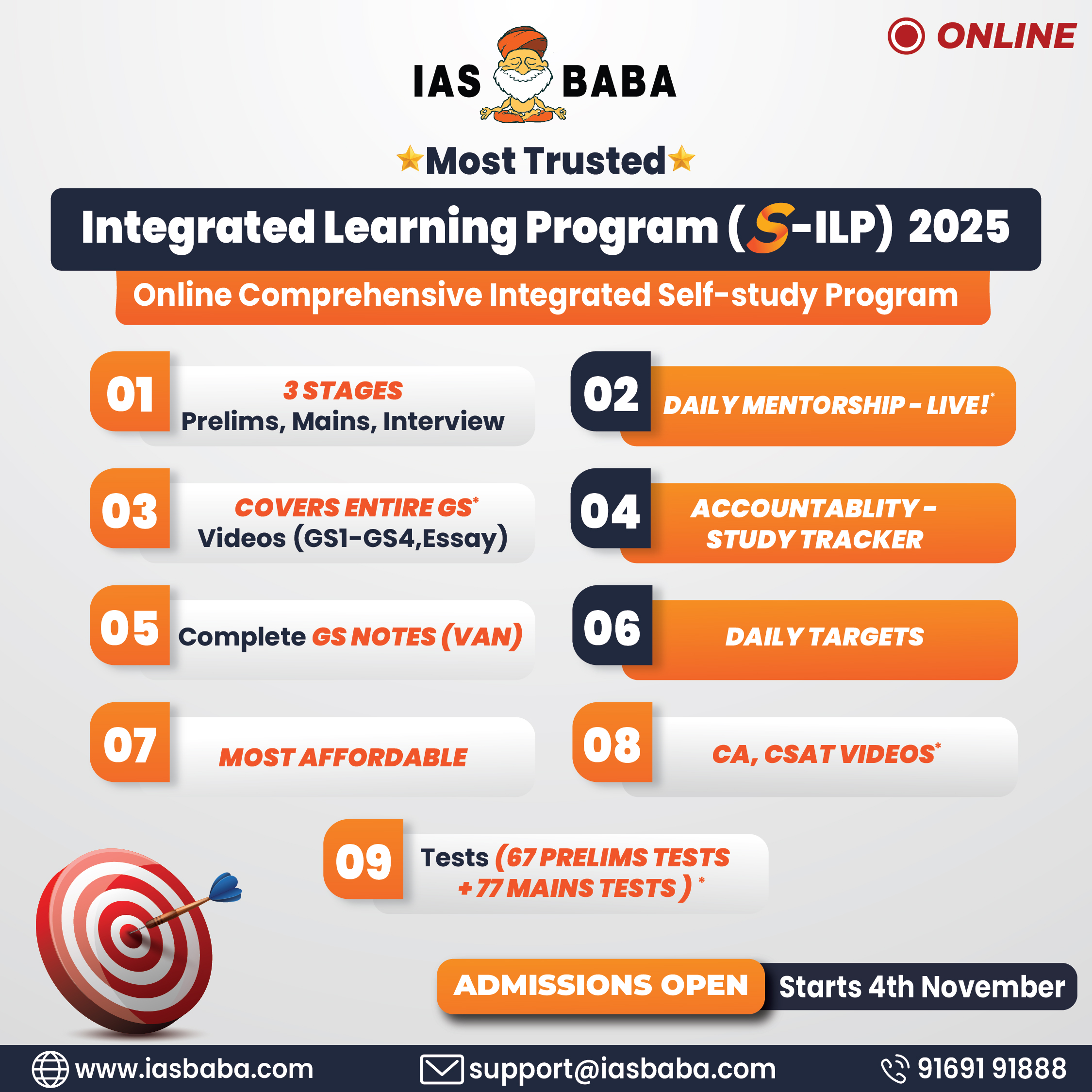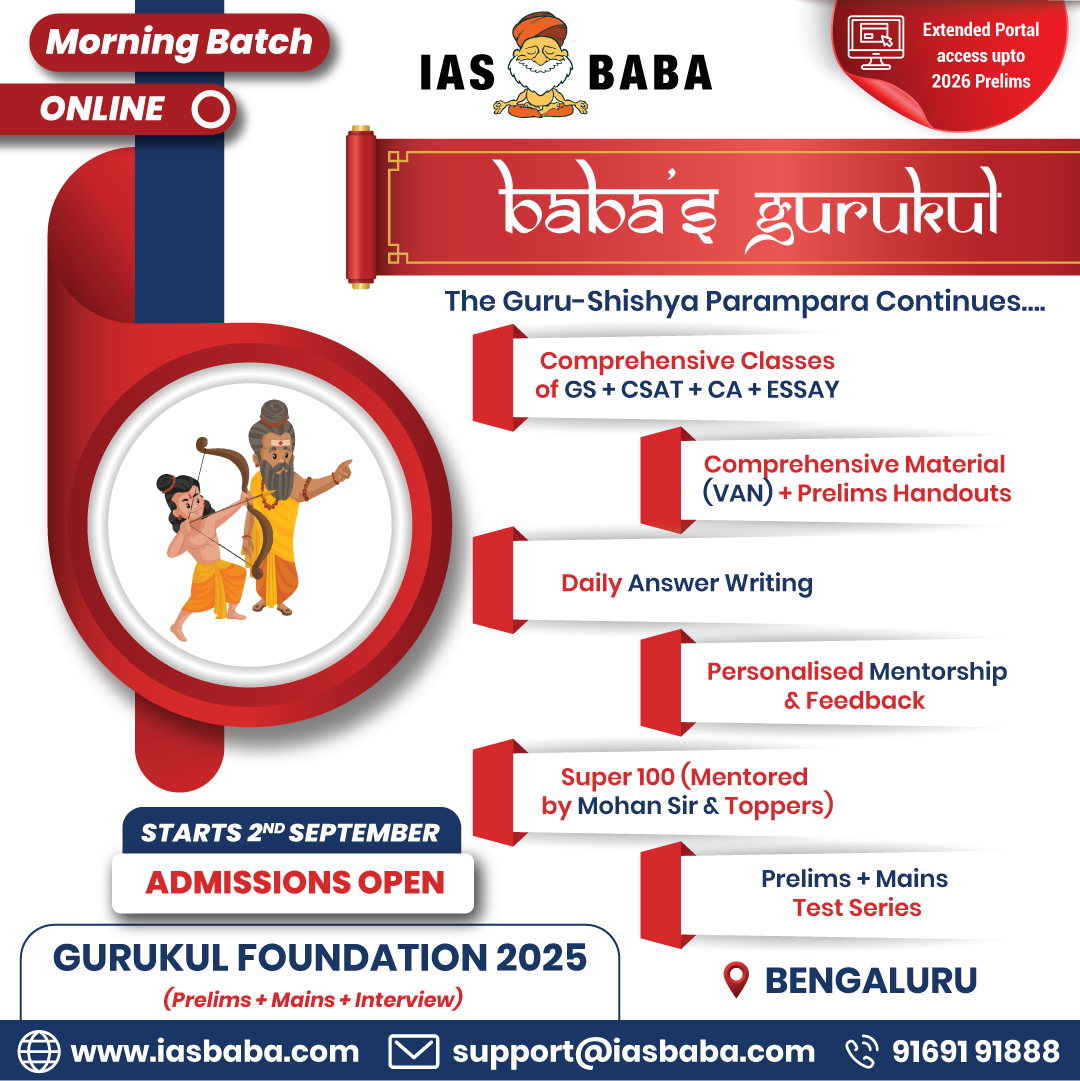IASbaba's Daily Current Affairs Analysis
Archives
(PRELIMS & MAINS Focus)
Syllabus
- Mains – HISTORY
Context: History has become a contested space with political parties muddying the water. The impact of invasions and migrations have become a closely watched arena.
Background:-
- Invaders typically seize wealth, take people as slaves, disrupt and control economic and political systems, and over time, alter the culture of the conquered land. Migration on the other hand involves gradual integration into a new place without immediate disruptions, though tensions may slowly develop as immigrant and native cultures interact.
Kinds of Invasion
- Raid: Raiders focus on looting wealth without seeking long-term control.Example: Mahmud of Ghazni’s raids in India a thousand years ago.
- Colonialism: Colonisers take over the political and economic systems and also get settled in the land. It was similar to what happened when the Delhi Sultanate was established by a mamluk, Qutubuddin Aibek, after the death of invader Muizzad-Din Muhammad Ghori.
- Imperialism: Imperialists extract wealth from a distant colony to the motherland. Examples: Italy and Britain during their colonial periods.
- Unique Case – Mughals: The Mughals with their marital ties with Rajputs, saw themselves as locals. Despite these ties, many natives did not accept them as locals.
Migrations and invasions in history
- All humans originated in Africa, with the first Indians migrating 60,000 years ago as part of the Out of Africa migration. The next major migration, 10,000 years ago, brought Iranian farmers to India, who introduced barley and wheat farming.
- From Southeast Asia, the Austro-Asiatic ‘Munda’ people migrated over 4,000 years ago. They introduced wet-rice farming. Then came the Aryans from Eurasia via Central Asia nearly 3,500 years ago. They introduced the horse. (As per the author Devdutt Pattanaik).
- The Persian empire regularly invaded North-Western India between the 6th-4th century BCE. They introduced the Aramaic script, which later evolved into Kharosthi script and was used for writing Prakrit and Sanskrit languages in the North-West.
- Besides, the Persian administrative practices of dividing territories into satrapies (provinces) and centralised bureaucracy were taken up by the Mauryas and the Guptas.
- In Mauryan times, Indians finally were inspired to invent the Brahmi script – a unique script that spread from India to Southeast Asia. Pillars were erected by kings to indicate power just like Persian Emperors.
Foreign Tribes and Their Impact
- Greeks, Scythians, Parthians, and Kushans (300 BCE-300 CE): Most of these tribes sought to control trade routes from the Ganga river basin through the Hindu Kush mountains to Persia.
- Many of them patronized Buddhism and Jainism, popularized the use of coins and stone images, especially in Gandhara and Mathura.
- Hunas (5th century CE): Came from Central Asia during the Gupta period.
- Huns were responsible for the destruction of Buddhist monasteries and the disintegration of the Gupta empire. This was also concurrent with the fall of the Roman Empire, an important trading partner for India.
- Later on, merchants became less important and agriculture rose to fill the gap. We see a gradual shift from Buddhist-mercantile culture to Brahmin-agricultural-temple culture. Sanskrit became the language of the court and spread from Afghanistan to Vietnam.
Arrival of Islam in India
- Islam emerged in 7th-century Arabia and reached coastal India through sailors. Early mosques were established on the western coasts in Gujarat, Konkan, and Kerala.
- Invasion by Central Asian Warlords (12th century): Central Asian warlords, newly converted to Islam, established control over Delhi.
- They took over the economic system, including tolls, taxes, and rent. They decided on the legal system as well, marking an invasion and a shift in governance.
Cultural and Administrative Changes:
- Persian replaced Sanskrit as the court language. Brahmins were sidelined in favor of Turks, Persians, and Afghans.
- Temples declined in importance, with mosques and royal tombs gaining prominence. Sufi saints, rather than Brahmins, received land grants.
Shift from Raj-Mandala to Persian Model:
- The relatively decentralized Raj-mandala system was replaced by the centralised Persian Iqta system, later evolving into the Mansab system under the Mughals.
- Introduction of kagaz (paper) and kalam (pen) replaced traditional materials like stone, copper, birch bark, and palm leaves.
From Portuguese to British Colonialism
Portuguese Colonialism (1510): Began with the conquest of Goa from the Bijapur Sultanate.
- Portuguese controlled the western coast and seas, introducing maritime taxes.
- They established Christian missions, introduced the printing press, and began translating local languages.
European Powers Follow: Other European powers like the Dutch, French, and English followed the Portuguese.
- They brought a new way of thinking based on science, mathematics, logic, and evidence, marking the onset of the Industrial Revolution. This challenged traditional agricultural and feudal systems worldwide.
Rise of British Colonialism (18th century):
- The sacking of Delhi by Nadir Shah of Iran and later Ahmad Shah Abdali exposed the Mughal Empire’s weakness. These events paved the way for the British East India Company to establish control, leading to British colonialism.
Impact on Indian Culture
- Invasions brought significant changes to Indian culture, from the introduction of new religious practices to shifts in administrative and economic systems.
- The influence of various invaders reshaped India’s social and cultural landscape, leading to the complex and diverse society seen today.
Source: Indian Express
Syllabus
- Prelims & Mains – CURRENT EVENT
Context: After a 7.1-magnitude earthquake shook southern Japan on August 8, the country’s meteorological agency issued its first-ever “megaquake advisory”. The warning said the likelihood of strong shaking and large tsunamis is higher than normal on the Nankai Trough.
Background:
- The advisory is a warning and not an accurate prediction of earthquake as such. The advisory asked residents to prepare, review evacuation routes, and consider potential future warnings.
Nankai Trough and Earthquake Risk in Japan
- The Nankai Trough is a 900 km long underwater subduction zone where the Eurasian Plate collides with the Philippine Sea Plate, pushing the latter under the former. This builds tectonic stress that can cause megaquakes (earthquakes with a magnitude larger than 8).
- Historically, the Nankai Trough has produced large earthquakes every 100 to 150 years, often in pairs, with the second quake occurring within two years of the first. The most recent pair occurred in 1944 and 1946.
Risk:
- A magnitude-7.1 earthquake occurred recently near the Nankai Trough, raising concerns about the potential for a devastating megaquake.
- In January 2022, Japan’s Earthquake Research Committee estimated a 70% probability of a magnitude 8-9 megaquake occurring along the Nankai Trough within the next 30 years.
- Such a quake could affect a large area from central Shizuoka to southwestern Miyazaki, with tsunami waves up to 98 feet high potentially reaching Japan’s Pacific coasts within minutes.
Potential Impact:
- A 2013 government report found that a major Nankai Trough earthquake could impact an area that covers about a third of Japan and where about half the country’s population of more than 120 million people lives.
- The economic damage due to the disaster could go up to $1.50 trillion, or more than a third of Japan’s annual gross domestic product.
Predicting Earthquakes:
- Earthquakes cannot be accurately predicted.
- An accurate prediction of an earthquake needs a precursory signal from within the earth, indicating a big quake is on the way. The signal must also occur only before large earthquakes so that it does not indicate every small movement within the earth’s surface. Currently, there is no equipment to find such precursors.
Source: Indian Express
Syllabus
- Prelims – CURRENT EVENT
Context: St. Martin’s Island has become a geopolitical hotspot. Former Bangladeshi Prime Minister Sheikh Hasina reportedly claimed that the US sought to acquire the island in exchange for political support.
Background:
- US State Department had denied Hasina’s allegations, describing them as not accurate.
About St. Martin’s Island
- With an area of just 3 square kilometres (sq km), St Martin’s Island, also known locally as “Narikel Zinzira” or “Coconut Island”, is located in the northeastern part of the Bay of Bengal.
- Saint Martin’s is located about 9 km south of the tip of the Cox’s Bazar-Teknaf peninsula, and forms the southernmost part of Bangladesh. There is a small adjoining island that is separated at high tide, calledChera Dwip.
- It is about 8 kilometres (5 miles) west of the northwest coast ofMyanmar, at the mouth of the Naf River.
- Millennia ago, the island used to be an extension of the Teknaf peninsula, but portion of this peninsula later got submerged and thus the southernmost part of the peninsula became an island and was disconnected from the Bangladesh mainland.
- The coral reef island is home to about 3,800 residents, most of whom are fishermen. St Martin’s is reportedly Bangladesh’s only coral island.
- During the rainy season, because of the dangerous conditions on the Bay of Bengal, the inhabitants have no scope to go to the mainland (Teknaf) and their life can become dangerous.
What is Saint Martin’s island’s history and current status?
- The Saint Martin’s island’s recorded history dates back at least to the eighteenth century, when Arabian merchants first settled there and named it “Jazira”.
- A British team of surveyors included the island as a part of then British India in 1900 and named it either after a Christian priest, called Saint Martin, or the then Deputy Commissioner of Chittagong, Mr Martin.
- The island continued to be a part of British India when Myanmar was separated from it in 1937. After the 1947 Partition of the Indian subcontinent, the island came under Pakistan’s control.
- Subsequently, the island became a part of Bangladesh after the 1971 Liberation War. And, in 1974, Bangladesh and Myanmar reached an agreement, under which the island was recognised as a part of Bangladeshi territory.
- Despite the 1974 agreement, issues did continue over the delimitation of the island’s maritime boundary, with a landmark 2012 judgment by the International Tribunal for the Law of the Sea subsequently affirming Bangladesh’s sovereignty over the island.
Why is St Martin’s Island geopolitically important?
- The US’ alleged interest in St Martin’s could be based on the fact that a base on the island would help Washington counter China’s influence in the Indian Ocean.
- St Martin’s location, its proximity to the Bay of Bengal, and its maritime boundary with Myanmar could be the reasons behind international interest in the island, particularly from the US and China.
Source: Business Standard
Syllabus
- Prelims – CURRENT EVENT
Context: Recently, the Indian Air Force and Royal Malaysian Air Force participated in Exercise Udara Shakti 2024.
Background:
- It was held from August 5-9, 2024, at the RMAF base in Kuantan, Malaysia.
Key takeaways:
- Exercise Udara Shakti 2024 is a significant bilateral air force exercise between the Indian Air Force (IAF) and the Royal Malaysian Air Force (RMAF).
- Exercise Udara Shakti aimed to enhance military cooperation and strengthen the strategic partnership between India and Malaysia.
- Both air forces deployed their Sukhoi Su-30 fighter jets for the exercise. The IAF participated with its Su-30MKI aircraft, while the RMAF fielded its Su-30MKM aircraft.
What other joint exercises have India participated in?
- Mitra Shakti: This is an annual exercise with Sri Lanka, focusing on counter-insurgency and counter-terrorism operations. The latest edition began on August 12, 2024, in Sri Lanka.
- Yudh Abhyas: A joint military exercise with the United States, aimed at improving interoperability and sharing best practices in counter-terrorism operations.
- Hand-in-Hand: Conducted with China, this exercise focuses on counter-terrorism and humanitarian assistance and disaster relief operations.
- Indra: A series of joint exercises with Russia, covering all three services (Army, Navy, and Air Force) to enhance bilateral defence cooperation.
- Shakti: A biennial exercise with France, focusing on counter-terrorism operations and enhancing interoperability between the two armies.
- Nomadic Elephant: Conducted with Mongolia, this exercise focuses on counter-insurgency and counter-terrorism operations.
Source: PIB
Syllabus
- Prelims & Mains – CURRENT EVENT
Context: The Union Cabinet, chaired by the Prime Minister Shri Narendra Modi, recently approved the Clean Plant Programme (CPP) proposed by the Ministry of Agriculture and Farmers Welfare.
Background:
- This programme is expected to significantly boost India’s horticultural sector, aligning with broader initiatives like Mission LiFE and One Health.
About Clean Plant Programme (CPP)
- The Clean Plant Programme (CPP) is a transformative initiative for India’s horticultural sector.
- By promoting sustainable and eco-friendly agricultural practices, it aims to reduce dependence on imported planting materials and enhance the quality and productivity of fruit crops.

- The CPP’s implementation by the National Horticulture Board, in collaboration with the Indian Council of Agricultural Research (ICAR), ensures that it leverages the best scientific and agricultural expertise available.
- This program aligns with broader initiatives like Mission LiFE and One Health, emphasizing environmental sustainability and public health.
Core Components:
- Clean Plant Centers (CPCs): Establish nine state-of-the-art centers equipped with advanced diagnostic and tissue culture labs to produce and maintain virus-free planting material.
- Certification and Legal Framework: Implement a robust certification system supported by the Seeds Act 1966 to ensure accountability and traceability in planting material production and sale.
- Enhanced Infrastructure: Provide support for large-scale nurseries to develop infrastructure for efficient multiplication of clean planting material.
Key Benefits of the Clean Plant Programme (CPP):
- Farmers: The CPP will provide access to virus-free, high-quality planting material, leading to increased crop yields and improved income opportunities.
- Nurseries: Streamlined certification processes and infrastructure support will enable nurseries to efficiently propagate clean planting material, fostering growth and sustainability.
- Consumers: The initiative will ensure that consumers benefit from superior produce that is free from viruses, enhancing the taste, appearance, and nutritional value of fruits.
- Exports: By producing higher-quality, disease-free fruits, India will strengthen its position as a leading global exporter, expanding market opportunities and increasing its share in the international fruit trade.
Source: PIB
Practice MCQs
Q1.) Exercise Udara Shakti 2024, recently seen in news is a bilateral air force exercise between India and
- Malaysia
- Thailand
- Sri Lanka
- Maldives
Q2.) With reference to the Clean Plant Programme (CPP), consider the following statements:
- The Clean Plant Programme aims to improve the quality and productivity of fruit crops across India.
- It provides support for large-scale nurseries to develop infrastructure for efficient multiplication of clean planting material.
- It is implementing by the National Horticulture Board, in collaboration with the Indian Council of Agricultural Research (ICAR).
Which of the statements given above is/are correct?
- 1 only
- 2 and 3 only
- 3 only
- 1,2 and 3
Q3.) St.Martins island, recently seen in news located in
- Red Sea
- Bay of Bengal
- Caribbean Sea
- Arabian Sea
Comment the answers to the above questions in the comment section below!!
ANSWERS FOR ’ 13th August 2024 – Daily Practice MCQs’ will be updated along with tomorrow’s Daily Current Affairs
ANSWERS FOR 12th August – Daily Practice MCQs
Q.1) – b
Q.2) – b
Q.3) – b











